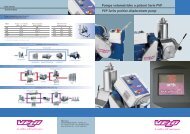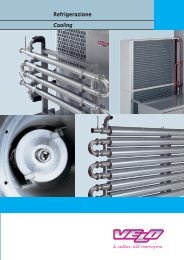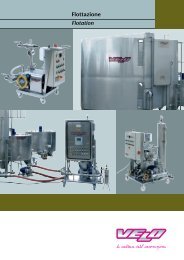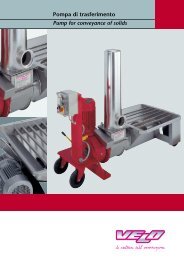Pressa pneumatica Pneumatic press - Castilla y Campos
Pressa pneumatica Pneumatic press - Castilla y Campos
Pressa pneumatica Pneumatic press - Castilla y Campos
- No tags were found...
Create successful ePaper yourself
Turn your PDF publications into a flip-book with our unique Google optimized e-Paper software.
<strong>Pressa</strong> <strong>pneumatica</strong><strong>Pneumatic</strong> <strong>press</strong>
<strong>Pressa</strong> <strong>pneumatica</strong><strong>Pneumatic</strong> <strong>press</strong>Le <strong>press</strong>e pneumatiche, massima es<strong>press</strong>ione della delicatezza in fase diesaurimento delle vinacce, sono tecnologie che danno la possibilità diottenere mosti da avviare alla fermentazione con caratteristichequalitative superiori a qualsiasi altro sistema di <strong>press</strong>atura. A seconda dellatipologia del prodotto da ottenere, possono essere fornite sia con gabbiaaperta che chiusa.Presse chiuse serie PMCGrazie alla loro particolare forma e con ben 2927 fori per mq, le canalineinterne delle <strong>press</strong>e Velo garantiscono grande capacità di sgrondo e uncompleto sgretolamento della vinaccia. Vi è inoltre da evidenziare comenovità assoluta il particolare sistema di aggancio delle stesse ideato inVelo, fornite come optional, che ne permette l’ispezionamento senzadoverle togliere dalla loro sede con l’unico onere per l’operatore disvitare una sola vite per canalina. Questa soluzione ha ridotto il numero ditraversi di tenuta cambiandoli di forma: così facendo si è drasticamentediminuito il rischio di ancoraggio dello sporco, sempre temibile inquesta fase della lavorazione delle uve.Nato in perfetta simbiosi in quanto sviluppato in seno allo stessoprogetto del sistema di aggancio, il dispositivo di lavaggio automaticoad alta <strong>press</strong>ione delle canaline, rappresenta il livello più alto ditecnologia in fatto di pulizia e di detersione delle <strong>press</strong>e disponibileattualmente sul mercato.Il sistema è stato progettato in assenza del benchè minimo compromesso;nulla è precluso all’utilizzatore in questa fase: si possono effettuarelavaggi con <strong>press</strong>ioni varianti da 10 a 90 atm, con temperature fino a 90 °C,effettuare aggiunte di sanificanti in linea, risciacqui con acqua caldapiuttosto che fredda, il tutto nella sequenza, nel numero e nella quantitàche il tecnico di cantina desidera.Il sistema è costituito da un tubo flessibile comprensivo di una testina dilavaggio provvista di retrogetti, che viene introdotto in ogni singolacanalina. L’avanzamento senza inceppamenti viene garantito dall’azioneidrodinamica dei getti d’acqua che fuoriescono dall’ugello sia in fase diavanzamento che in quella di recupero del tubo ad alta <strong>press</strong>ione.<strong>Pneumatic</strong> <strong>press</strong>es, offering remarkably delicate grape pulp <strong>press</strong>ing, aretechnologies that obtain a higher quality of fermentation must than anyother <strong>press</strong>ing system. Depending on the product required, they can besupplied both with open cage and closed cage.PMC series closed <strong>press</strong>esThanks to their special shape and to 2927 holes per square metre, theinternal ducts of the Velo <strong>press</strong>es offer outstanding draining capacityand complete disintegration of the grape pulp.A brand-new duct connection system has also been designed by Velo;supplied as an optional accessory, it allows ducts to be inspected withouthaving to remove them; the operator must only remove a singlescrew per duct.This solution has reduced the number of stop bars and changed their shape:this has drastically reduced the risk of the residues sticking, aproblem that is quite common during this processing phase.Perfectly compatible, with the connection system since it was developedtogether with it, the high <strong>press</strong>ure automatic duct washing deviceis the most advanced technology for cleaning and washing <strong>press</strong>escurrently available on the market.This compromise-free system offers users outstanding flexibility in this phase:washing can be performed at <strong>press</strong>ures varying from 10 to 90 atm and attemperatures of up to 90°C, sanitation products can be added in line, hotwater can be used for rinsing rather than cold water, and the sequence,number and quantity of the above can be modified according to productionrequirements.The system comprises a flexible hose fitted with a retrojet washing headwhich is introduced automatically into each duct .Unobstructed movement is guaranteed by the hydrodynamic action of thejets of water from the nozzle both during insertion and return of the high<strong>press</strong>ure hose.
<strong>Pressa</strong> <strong>pneumatica</strong><strong>Pneumatic</strong> <strong>press</strong>PMC 250cip lavaggio canalineduct washing cip
<strong>Pressa</strong> <strong>pneumatica</strong><strong>Pneumatic</strong> <strong>press</strong>PMC 250 EVOLUTION
<strong>Pressa</strong> <strong>pneumatica</strong><strong>Pneumatic</strong> <strong>press</strong>PMC 250 EVOLUTIONPMC EVOLUTIONPMC EVOLUTIONLe novità nel campo delle <strong>press</strong>e pneumatiche sono volte alla ricerca di soluzioniche impediscano, o comunque rallentino, i processi ossidativi del mosto all’attodella <strong>press</strong>atura. Lo sviluppo di un progetto riguardante metodologie di lavoroin ambiente riducente, ha portato la VELO SpA a realizzare la serie EVOLU-TION, <strong>press</strong>e a tank chiuso dove prima del caricamento del pigiadiraspato l’ariaviene sostituita con del gas inerte (solitamente azoto). L’azione di protezionedella vinaccia dall’ossidazione continua anche nella fase di de<strong>press</strong>ione impedendoall’aria di entrare neltank tramite valvole a ghigliottinaposte sui bocchettoni diuscita del mosto. Nella fase disgretolamento due pompeperistaltiche inietteno sullavinaccia una soluzione di acidoascorbico e metabisolfito dipotassio per poter garantire ilmassimo della protezione dall’ossigeno.Tutte queste attenzioniservono a far si che icostituenti più “delicati” (catechine,leucoantociani, ecc.)non vengano ossidati in questafase e che quindi pregiudichinola stabilità del vino futuro.Non di meno questi accorgimentisono oltremodo necessarise ci si trova in presenza diuve botritizzate dove la caricadi enzimi come polifenolossidasiè massima e l’unico mododi inibirli e quello di utilizzareagenti altamente riducenti e proteggere in generale il mosto dall’aria. E’ facileintuire come questa procedura di lavorazione sia adatta anche per uve contenenticomposti solforati odorosi, quali il Sauvignon, dove è oramai assodato chela vinificazione in riduzione sia “conditio sine qua non” per poterli preservare. La<strong>press</strong>a prevede inoltre che il carico assiale non entri dal centro di uno dei duefondi, ma nel mezzo del fasciame, ricalcando così il carico da portello senzaavere gli inconvenienti di questo e con la comodità del carico assiale propriamentedetto. Questa ultima soluzione serve a limitare quanto più possibile lerotazioni del tamburo in fase di carico, diminuendo sensibilmente la produzionedi solidi sospesi. I comandi di apertura e chiusura delle valvole, l’insuflaggiodell’azoto, gli sgretolamenti e il loro numero e le quantità dei liquidi riducentiin base al volume di vinaccia rimasto in <strong>press</strong>a alla fine di ogni ciclo, sono tutticomandati da un PLC tramite un PC con schermo touch screen che permettel’immediata visione dello stadio di funzionamento unendo praticità e benessereergonomico dell’operatore.The latest developments in the field of pneumatic <strong>press</strong>es are based on solutionswhich prevent, or at least slow down, the must oxidation processes during <strong>press</strong>ing.The development of a project featuring processing methods in a reducing atmosphereled VELO SpA to produce the EVOLUTION series, closed-tank <strong>press</strong>es in whichthe air is replaced with inert gas (generally nitrogen) before the <strong>press</strong>ed and stalkedgrapes are loading. The pulp is also protected from continuous oxidation during thede<strong>press</strong>ion stage thanks to the use of slide valves on the must outlets which preventair from entering the tank. Duringthe crumbling phase, two peristalticpumps inject a solution ofascorbic acid and potassium ontothe pulp in order to fully protectthe product from oxygen. Thesesystems ensure that the most“delicate” components (catechins,leucoantocians, etc.) are not oxidisedduring this phase, a thing thatwould negatively affect the stabilityof the future wine. Thesesystems are equally necessary forbotrytised grapes containing largequantities of enzymes, such aspolyphenoloxidase. The only wayof inhibiting them is to use reducingagents and generally protectthe must from the air. This process,of course, is also suitable for grapescontaining aromatic sulphides,such as Sauvignon, where it is bynow a well-known fact that reduction-basedvinification is an essentialelement for maintaining them. The <strong>press</strong> also ensures that axial feeding does nottake place in the centre of the cover or the bottom, but in the middle of the shell,thereby doing the same job as hatch feeding without the related problems and withthe commodity of axial feeding. The latter solution limits drum rotation during feedingas much as possible, thereby considerably reducing the production of suspendedsolids. Valve open-close commands, nitrogen insufflation, crumbling and thequantities of reducing liquids depending on the volume of pulp remaining in the<strong>press</strong> at the end of each cycle, are all PLC-controlled through a PC featuring a touchscreen that displays the operating phase in real time, thereby combining practicalitywith ergonomic comfort for the operator.
<strong>Pressa</strong> <strong>pneumatica</strong><strong>Pneumatic</strong> <strong>press</strong>PMA 250Presse aperte serie PMACaratteristica principale di queste <strong>press</strong>e è di avere il tamburo forato sumetà della superfice. L’alta densità dei fori, pari a 1.250 per metroquadrato, rende questa serie particolarmente adatta alla <strong>press</strong>atura divinaccia macerata o fermentata. La pulizia esterna del tamburo ègarantita da una barra laterale (optional) sulla quale sono montati degliugelli per il lavaggio con acqua ad alta <strong>press</strong>ione, eventualmente ancheaddizionata di sanificanti o detergenti (vedi particolare a lato).PMA series open <strong>press</strong>esThe main feature of this <strong>press</strong> is that half the drum surface is perforated.The high density of the holes, 1.250 per square metre, makes this seriesparticularly suitable for <strong>press</strong>ing macerated or fermented grape pulp.The exterior of the drum is washed with high <strong>press</strong>ure water from thenozzles mounted on a side bar (optional); sanitising liquids or detergents canalso be added (see detail to side).
<strong>Pressa</strong> <strong>pneumatica</strong><strong>Pneumatic</strong> <strong>press</strong>PMC 30Sistema elettronico di controllo e programmazionePLC Con tastiera digitale (mod. 250 e superiori)With digital keyboard (mod. 250 and bigger)Il sistema elettronico è stato progettato per permettere un controllo completo ditutte le funzioni tramite un PLC. E’ possibile determinare la durata delle fasi di<strong>press</strong>atura e le <strong>press</strong>ioni di lavoro da utilizzare durante i vari cicli tenendocontemporaneamente sotto controllo tutti gli allarmi. I modelli dalla 10 alla 150,sia PMA che PMC, sono dotate di una versione che prevede di base 5 programmiinseriti con l’esclusione del controllo del CIP di lavaggio. Nei modelli di tagliasuperiore la memoria presente permette di avere a disposizione 10 programmiper ognuno dei 3 tipi di <strong>press</strong>atura preimpostati per un totale di 30 programmitutti modificabili a seconda delle esigenze delle singole realtà. Completa il giànutrito quadro il programma “intelligente” di <strong>press</strong>atura I.P.S. (IntelligentPressing System), che consiste nella gestione completamente automatica dei ciclidi gonfiaggio della membrana, ottimizzando così la tempistica con tangibilirisultati di risparmio di tempo. Entrambe le versioni del PLC offrono l’assolutagaranzia di una precisa temporizzazione e la certezza del raggiungimento delle<strong>press</strong>ioni desiderate, unendo semplicità d’uso e benessere ergonomicodell’operatore.
PMA 10Electronic control and programming systemThis electronic system has been designed to totally control all functions bymeans of a PLC. The duration of the <strong>press</strong>ing phases and the operating<strong>press</strong>ures used during the various cycles can be selected while controlling all thealarms at the same time. Models 10 to 150, both PMA and PMC, are fitted with astandard version which allows up to 5 programmes to be entered except for CIPcleaning control. In bigger capacity models, the memory can store up to10 programmes for each of the 3 pre-set <strong>press</strong>ing types for a total of30 programmes which can all be modified depending on individual userrequirements. The several innovations incorporated in the system are completed withthe I.P.S. intelligent <strong>press</strong>ing system which automatically manages the membraneinflation cycles, thereby optimising timing and saving a lot of time.Both versions of PLC offer precision timing and the certainty of reaching the required<strong>press</strong>ure, combining simplicity of use with operator comfort.PLC Touch screen integrato (mod. 10/150)With built-in touch screen (mod. 10/150)
Dati tecniciTechnical data<strong>Pressa</strong> <strong>pneumatica</strong><strong>Pneumatic</strong> <strong>press</strong>Mod.VOLUMEDEL SERBATOIOVOLUME OFVESSELPIGIATOCRUSHCAPACITÀ DI CARICOLOADING CAPACITYFERMENTATOFERMENTEDCAPACITÀ VASCARACCOLTA SUCCOCAPACITY OF JUICECOLLECTING BASINCOMPRESSORECOMPRESSORPOTENZA INSTALLATA INSTALLED POWER(400 V / 3 / 50 Hz)SOFFIANTE/POMPA A VUOTOAIR BLOWER/VACUUM PUMPMOTOREROTAZIONEROTATIONMOTORPMA PMC L kg kg L kW kW kW A(mm) B(mm) C(mm)4 - 400 600 ÷ 1.200 1.200 ÷ 2.000 200 0,37 - 0,75 1.750 1.050 1.4507 - 660 1000 ÷ 2.000 2.000 ÷ 3.300 240 0,37 - 0,75 2.505 1.050 1.48010 - 1.000 1.500 ÷ 3.000 3.000 ÷ 5.000 320 0,55 - 0,75 2.560 1.280 1.65015 15 1.500 2.200 ÷ 4.500 4.500 ÷ 7.500 230 1,85 - 1,5 2.760 1.400 1.76022 22 2.100 3.100 ÷ 6.200 6.200 ÷ 10.500 370 3 - 1,5 3.500 1.350 1.74030 30 3.200 4.800 ÷ 9.600 9.600 ÷ 16.000 350 3 - 1,1 3.790 1.660 1.95050 50 5.200 7.800 ÷ 15.600 15.600 ÷ 26.000 510 4 1,5 1,85 4.450 1.860 2.17070 70 6.700 10.000 ÷ 20.000 20.000 ÷ 33.500 630 5,5 1,5 2,2 5.420 2.030 2.520100 100 9.700 15.000 ÷ 30.000 30.000 ÷ 48.500 970 7,5 3 3 6.920 2.030 2.520150 150 15.000 22.000 ÷ 45.000 45.000 ÷ 75.000 1.020 7,5 3 5,5 8.420 2.260 2.630250 250 25.4003709.700 3.200 2.700 (2)38.000 ÷ 76.000 76.000 ÷ 127.0009,2 7,5 7,5250 (1) 250 (1) 24.500 370 8.500 3.300 2.950 (2)- 320 (1) 33.30037011.700 3.200 2.700 (2)48.000 ÷ 96.000 96.000 ÷ 160.0009,2 7,5 9,2- 320 (1) 31.300 370 10.050 3.300 2.950 (2)- 400 41.4002 x 37012.050 3.300 2.950 (2)62.000 ÷ 125.000 125.000 ÷ 207.00018,4 11 11- 400 (1) 40.700 2 x 570 10.350 3.600 3.250 (2)- 550 52.200 78.000 ÷ 156.000 156.000 ÷ 261.000 2 x 570 18,4 11 11 12.350 3.600 3.250 (2)Note:I modelli PMA e PMC 250 ÷ 550 hanno il gruppo com<strong>press</strong>ori/quadro comandi remoto.(1): Esecuzione non standard.(2): Escluse prolunghe gambe.Note:Models PMA and PMC 250 ÷ 550 are supplied with remote com<strong>press</strong>ors and control board.(1): Special execution.(2): Excluding legs extension.ADG MasterVELO S.p.A.31030 ALTIVOLE (TV) Italy Via Piave, 55Tel. +39 0423 917100 Fax +39 0423 915235www.velo-group.com e-mail: velo@velo .it






